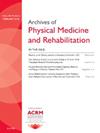使用机器人假肢足模拟器的新型假肢足处方“试驾”策略
IF 3.6
2区 医学
Q1 REHABILITATION
Archives of physical medicine and rehabilitation
Pub Date : 2025-05-01
DOI:10.1016/j.apmr.2025.03.016
引用次数: 0
摘要
选择一个最佳的假肢足是至关重要的,以最大限度地提高活动能力和实现功能目标的人的下肢丧失。然而,患者通常没有机会为足部选择过程提供经验输入。本研究旨在评估一种创新的“试驾”策略。68名胫骨截肢患者分别试用了3只商业假肢脚和3只相应的模拟脚,使用机器人足模拟器,该机器人足模拟器可以通过软件界面在实验室的水平、倾斜和楼梯跑步机上行走时在脚之间切换。然后参与者穿着每只商业脚进行连续两周的社区试验。所有的足部情况都是随机的,参与者是盲法的。脚的偏好在0-10的范围内测量。在每个社区试验之后,参与者还完成了自我报告和基于绩效的测量。线性混合效应回归用于评估结果之间的关联。模拟脚试验的初始脚偏好得分与相应的商业脚社区试验后的偏好得分相关(p= 0.001),与Trinity截肢和假肢体验量表-功能满意度得分相关(p= 0.036),但与两分钟步行测试、假肢使用者流动性调查或活动平衡信心得分无关。对48/68名参与者来说,模拟脚在实验室试验后最受欢迎的脚与相应的商业脚在社区试验后最受欢迎的脚相匹配。这些结果表明,使用假肢足模拟器的以患者为中心的“试驾”策略可能会提高假肢足的处方,并提高下肢截肢患者的满意度。本文章由计算机程序翻译,如有差异,请以英文原文为准。
A Novel 'Test-Drive' Strategy for Prosthetic Foot Prescription Using a Robotic Prosthetic Foot Emulator
Selecting an optimal prosthetic foot is vital to maximizing mobility and achieving functional goals in people with lower limb loss. However, patients do not generally have an opportunity to provide experiential input to the foot selection process. This study aimed to assess an innovative 'test-drive' strategy for foot selection. Sixty-eight individuals with transtibial amputation each trialed three commercial prosthetic feet and three corresponding emulated feet using a robotic foot emulator capable of switching between feet via a software interface during walking on level, inclined, and stair treadmills in the laboratory. Participants then wore each commercial foot for consecutive two-week community trials. All foot conditions were randomized and participant-blinded. Foot preference was measured on a 0-10 scale. Following each community trial, participants also completed self-reported and performance-based measures. Linear mixed-effects regression was used to assess associations between outcomes. Initial foot preference scores from trials with emulated feet correlated with preference scores after community trials with the corresponding commercial feet (p<.001) and with Trinity Amputation and Prosthesis Experience Scales–Functional Satisfaction score (p=.036), but not with Two Minute Walk Test, Prosthetic Limb Users Survey of Mobility, or Activity-Balance Confidence scores. The most-preferred foot after the after the in-lab trial of the emulated foot matched the most-preferred foot after the community trial of the corresponding commercial foot for 48/68 participants. These results suggest that a patient-centered 'test-drive' strategy using a prosthetic foot emulator could potentially enhance prosthetic foot prescription and lead to improved patient satisfaction outcomes in people with lower limb amputation.
求助全文
通过发布文献求助,成功后即可免费获取论文全文。
去求助
来源期刊
CiteScore
6.20
自引率
4.70%
发文量
495
审稿时长
38 days
期刊介绍:
The Archives of Physical Medicine and Rehabilitation publishes original, peer-reviewed research and clinical reports on important trends and developments in physical medicine and rehabilitation and related fields. This international journal brings researchers and clinicians authoritative information on the therapeutic utilization of physical, behavioral and pharmaceutical agents in providing comprehensive care for individuals with chronic illness and disabilities.
Archives began publication in 1920, publishes monthly, and is the official journal of the American Congress of Rehabilitation Medicine. Its papers are cited more often than any other rehabilitation journal.

 求助内容:
求助内容: 应助结果提醒方式:
应助结果提醒方式:


